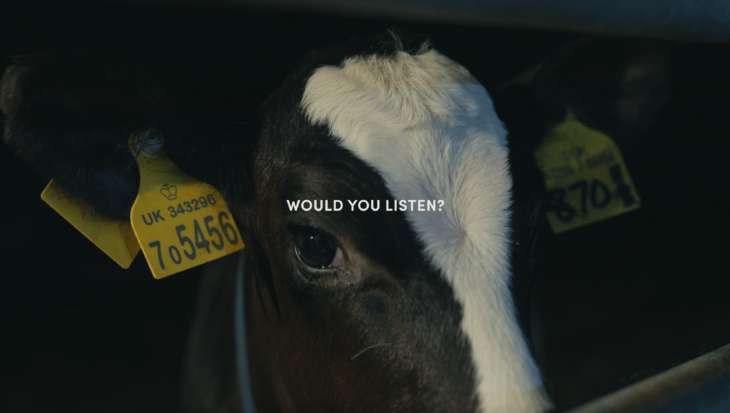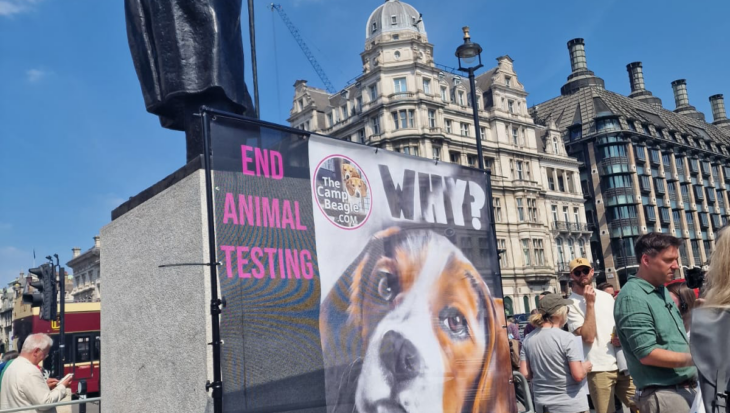The making of the UK’s first anti-dairy TV and Cinema advert, plus an exclusive look at the UNCENSORED version
Posted 06 May 2025

Posted on the 19th February 2016
Fifteen years ago (as of 19 February 2016) what would turn out to be a traumatic epidemic of foot and mouth disease began with the discovery of disease symptoms in 27 pigs sent for slaughter to Essex abattoir Cheale Meats.
(This is the same Cheale Meats, two of whose workers were jailed for animal cruelty following a 2012 Animal Aid undercover investigation, which showed pigs being punched, burnt with cigarettes and beaten with sticks.)
By the time the foot and mouth crisis was formally at an end on 14 January, 2002, some six million animals had been killed, often in the most brutal and incompetent manner. There was evidence of animals shot with captive bolt guns recovering consciousness – and it was feared that many, whilst still alive, were drenched with disinfectant and shovelled into specially dug pits. Young pigs, lambs and calves, whose skulls were too soft for the bolt gun, were killed with an injection directly into their hearts – an extraordinarily painful procedure that is banned by the American Veterinary Association, except where animals are heavily sedated. And because handsome sums of compensation were available to farmers whether or not they fed their doomed animals, animals were reported to be going unfed between the time of their slaughter being ordered and the actual killing. This could be for seven or eight days.
A report by the Royal Society estimated that £2.5 billion was paid out by the government by way of compensation for animals destroyed, as well as for disposal and clean-up costs. Huge sums were also forfeited by a variety of businesses and individuals as a result of the virtual closing down of the countryside.
Although Animal Aid and other animal rights campaigners worked tirelessly to spread our message about why foot and mouth had happened and how to prevent such catastrophes in the future, we were not only essentially deprived of a public voice, some journalists attacked us in print for being complacent and not caring. Much of the widely felt distress was prompted by people having to witness, for the first time, what is always concealed behind the closed doors of slaughterhouses. On their TV screens, they were seeing animals, helpless with fear and confusion, being roughed up and killed. They also saw newborn lambs dying in the rain and mud, and animals shovelled into pits and hoisted onto funeral pyres.
Farmers Weekly reported (18 May, 2001) on a group of cattle in North Devon who took flight when they saw their fellows being shot. They were finally cornered in a neighbouring field. The industry journal describes how they were ‘huddling terrified under the hedge in full view from the village while marksmen shot at them’.
One of the livelier protests we staged was at the headquarters of the National Farmers Union in London, where our banners and slogans reflected the mayhem and social and economic devastation caused by the crisis. While farmers in the real world showed few signs of contrition, our ‘farmers’ at NFU headquarters were apologetic. Banners read: ‘Sorry for the animal suffering’ … ‘Sorry for sponging off tax payers’ … ‘Sorry for polluting the environment’ … ‘Sorry for closing down the countryside’ … ‘Sorry for pretending that killing animals isn’t our living’ and so on.
There was little consensus as to either the cause of foot and mouth or who the real victims were. We saw weeping farmers on TV, endless recriminations and scapegoating of innocent parties and even media sob stories about the awful burden befalling slaughter gangs as they chased down and exterminated animals with terrible ineptitude.
Blame, meanwhile, settled on a whole cast of contemporary villains, including foreign meat dealers (not least from China), waste food fed to pigs and dark deeds by eco-terrorists. There was even a biological warfare plot, in which Porton Down was said to have played a role.
In fact, foot and mouth was just the latest in a series of disease outbreaks afflicting farmed animals. Others included salmonella, campylobacter, E. coli, swine fever, bovine TB and BSE. There have been more disease panics since 2001 (including MRSA, Johne’s disease and Q fever). And they will keep coming for as long as animals are treated as though they are mere tradable commodities. Whatever the specific cause of the FMD outbreak, it is a condition, like many others, that flourishes in the squalid and oppressive systems of animal breeding, transportation and slaughter favoured by the animal production industry.
After the foot and mouth epidemic, Animal Aid tested whether the industry had learnt anything at all from such a costly and painful episode. We visited 13 livestock markets between June 2003 and March 2004 to monitor adherence to measures introduced to prevent another outbreak or similar catastrophe. Markets were shown to have played a central role in the wide and rapid dissemination of foot and mouth, due to the large number of animals who passed through them. We visited markets all over the country and at each one we saw even the most basic biosecurity rule being disregarded. This required that everyone disinfect his or her footwear on leaving the animal areas. Failure to obey this rule was so commonplace that one of our undercover market monitors reported having to conceal the fact that he was dipping his boots, for fear his diligence would have exposed him as an outsider.
Have we learnt the lessons of foot and mouth? We clearly haven’t. Could the same, or something very similar, happen again? The answer has to be yes.
Andrew Tyler, Director of Animal Aid
Order a FREE Go Vegan packPosted 06 May 2025

Yesterday, Michelle, our Head of Campaigns, headed into London to attend the debate on the government petition which urged ‘Ban immediately the use of dogs in scientific and regulatory procedures’.
Posted 29 Apr 2025
